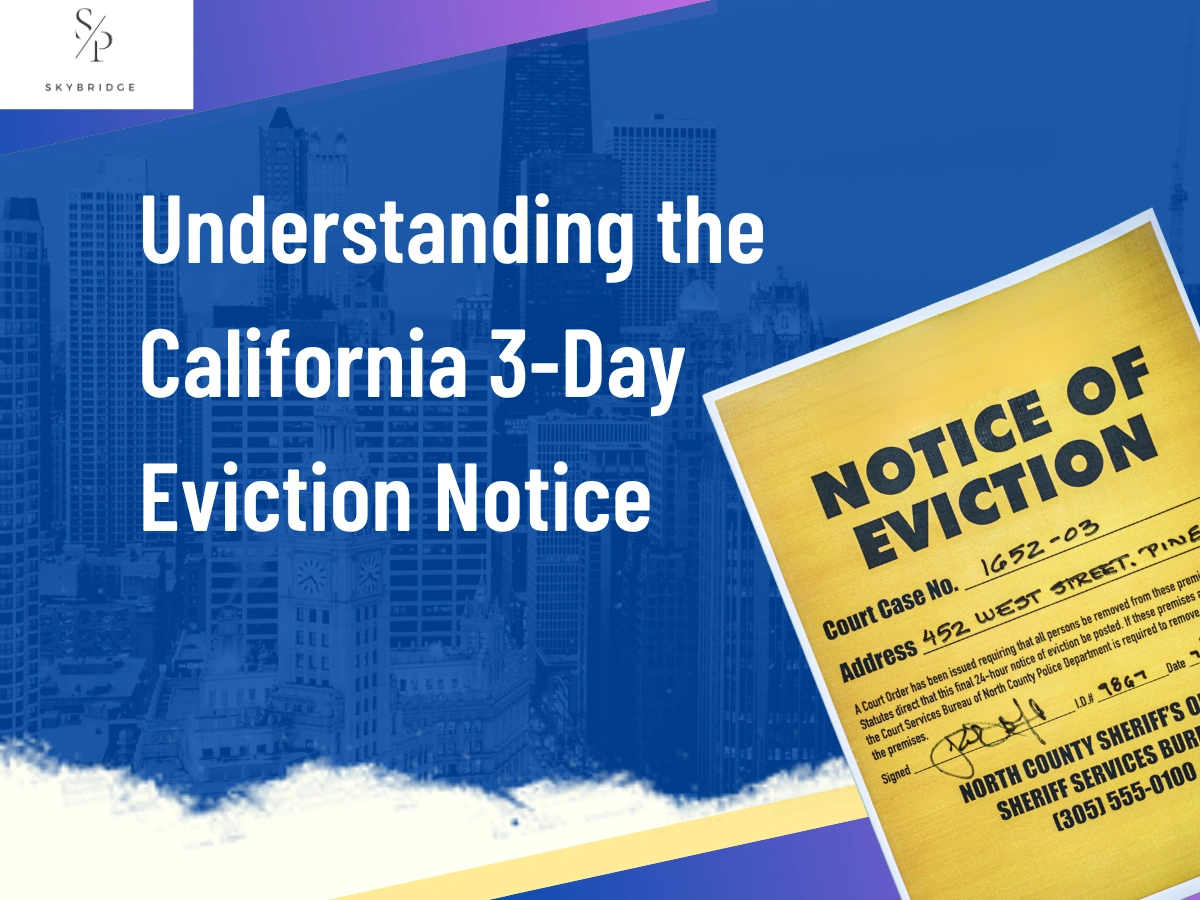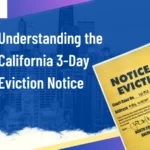A 3-Day Eviction Notice in California is a legal document used by landlords to address tenant violations, such as unpaid rent or breaches of the lease agreement. It serves as a formal warning, giving tenants three days to either correct the issue, like paying overdue rent, or vacate the property. If the tenant does not comply, the landlord may proceed with the eviction process.
This notice is a crucial part of California’s eviction laws, ensuring that landlords give tenants a fair chance to resolve issues before taking legal action. There are different types of 3-Day notices, including the 3-Day Notice to Pay or Quit, issued for unpaid rent, the 3-Day Notice to Perform Covenants or Quit, issued for violations that can be fixed, and the 3-Day Notice to Quit, issued for serious illegal violations that require the tenant to vacate without a chance for correction.
Each type of notice provides a structured framework for landlords to address tenant violations while ensuring tenants have the opportunity to correct the issue before legal proceedings begin.
What Is a 3-Day Notice?
A 3-Day Notice is a formal written document issued by landlords to tenants who violate their rental agreement. It gives tenants a 3-day period to comply with lease terms, such as paying overdue rent or fixing a lease violation, or to vacate the property. If the tenant does not comply within this period, the landlord can initiate the eviction process. There are different types of 3-Day Notices depending on the violation, including the 3-Day Notice to Pay or Quit (for unpaid rent), the 3-Day Notice to Perform Covenants or Quit (for lease violations that can be fixed), and the 3-Day Notice to Quit (for serious violations that require the tenant to vacate without an opportunity to remedy the situation).
The notice must include essential information for it to be valid under California law. This includes the tenant’s name and property address, the amount owed if the notice relates to unpaid rent, and a clear deadline of 3 full calendar days. The notice also needs to include instructions on how the tenant can either comply with the notice or vacate the property. For the notice to be legally enforceable, it must be precise, clear, and meet California’s legal requirements.
Types of Eviction Notices in California
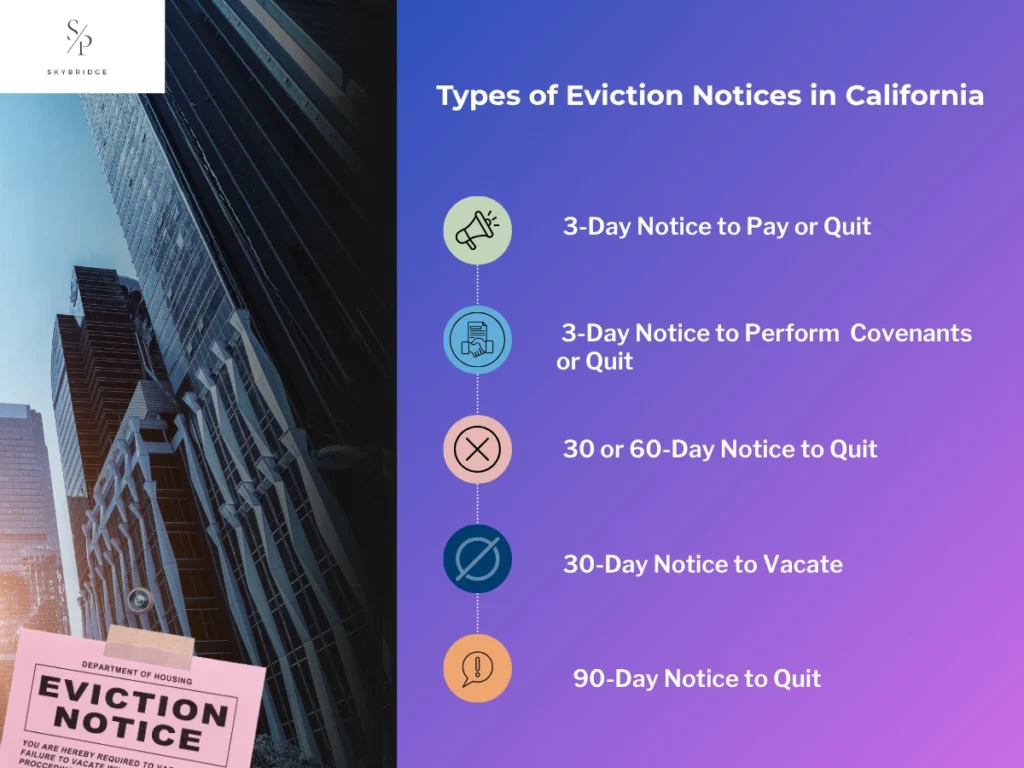
In California, various types of eviction notices are issued based on tenant violations. These include the 3-Day Notice to Pay or Quit, issued for unpaid rent, and the 3-Day Notice to Perform Covenants or Quit, given for lease violations that can be corrected. The 30/60-Day Notice to Quit is used to terminate month-to-month leases, while the 90-Day Notice to Quit applies to Section 8 tenants, providing extended time for vacating. Additionally, the 3-Day Notice to Quit (Move Out) is issued for serious violations such as causing a nuisance, engaging in illegal activities, damaging the property, or subletting without permission, requiring tenants to vacate immediately without the chance to correct the issue. Each eviction notice follows distinct legal requirements and gives tenants an opportunity to resolve issues or vacate the property as required.
3-Day Notice to Pay or Quit
A 3-Day Notice to Pay or Quit is issued when a tenant fails to pay rent on time. This notice provides the tenant with three days to either pay the overdue rent or vacate the property. The notice must be in writing and include the tenant’s full name, the rental property address, and the amount of rent owed. The notice also provides clear instructions for payment, such as where to pay in person or by mail. Importantly, the notice does not cover other charges like late fees, utilities, or damages. If the tenant does not comply within the 3-day period, the landlord may initiate legal eviction proceedings. The three-day period excludes weekends, holidays, and court holidays.
If the tenant falls under the Tenant Protection Act, they must receive a 3-Day Notice to Pay Rent or Quit before a 3-Day Notice to Quit can be issued. The 3-Day Notice to Quit does not allow the tenant to fix the problem, and it is used to end the tenancy.
What if the Tenant Has Already Moved Out?
If the tenant has already vacated the property before the notice is served, the eviction process is generally halted. However, the landlord may still seek payment for any unpaid rent or damages through other legal avenues.
3-Day Notice to Perform Covenants or Quit
A 3-Day Notice to Perform Covenants or Quit is used when a tenant violates a term of the lease that can be fixed, such as keeping an unauthorized pet or disturbing neighbors. The notice provides the tenant with three days to correct the violation or vacate the property. This notice must be in writing and include the tenant’s full name, the rental property address, and a description of the violation. If required by local laws, a cease and desist letter must be included, specifying the date it was sent. The tenant is given the opportunity to fix the problem within the 3-day period, or they must vacate the premises. If the violation is not fixed in the specified time, the landlord can pursue eviction.
3-Day Notice to Quit
A 3-Day Notice to Quit is issued when a tenant engages in serious violations that justify immediate termination of tenancy. These violations include causing a nuisance on the property, engaging in illegal activities (such as drug dealing), endangering health and safety (e.g., using hazardous chemicals), committing significant property damage (waste), or subletting without permission. This notice demands that the tenant vacate the property immediately, with no opportunity to correct the violation.
If the tenant fails to comply with a 3-Day Notice to Perform Covenants or Quit and the violation remains unresolved, a 3-Day Notice to Quit may follow. The notice must include the tenant’s full name, the property address, a detailed description of the violation, and a clear deadline for vacating. Tenants are required to move out within three calendar days from receiving the notice, and weekends or holidays do not extend the deadline. This notice may also be referred to as a 3-Day Unconditional Notice to Quit or 3-Day Notice to Vacate.
30 or 60-Day Notice to Quit
The 30 or 60-Day Notice to Quit is used to terminate a month-to-month lease. A 30-Day Notice is required if the tenant has lived on the property for less than a year. If the tenant has lived there for more than a year, the landlord must issue a 60-Day Notice to Quit. This notice does not require a specific reason, and the landlord is free to terminate the tenancy without cause. However, landlords must comply with the Tenant Protection Act, which may require a just cause for ending the tenancy, such as making required repairs or selling the property. If applicable, the landlord may also be required to provide relocation assistance to the tenant.
30-Day Notice to Vacate
A 30-Day Notice to Vacate is typically used when the tenant has a month-to-month lease, and the landlord wishes to end the agreement. The tenant must vacate the property within 30 days of receiving the notice. This notice is commonly issued when the landlord does not wish to renew the lease or intends to lease the property to someone else. This notice is legally required when the landlord wants to terminate a tenancy without cause.
90-Day Notice to Quit
A 90-Day Notice to Quit is specifically used for tenants who are part of the Section 8 Housing Program. This extended notice period gives tenants more time to find alternative housing compared to standard eviction notices. This notice complies with federal regulations that protect tenants in subsidized housing. The 90-day period provides tenants with the necessary time to secure new housing or resolve the situation before eviction.
What is Included in a 3-Day Notice in California?
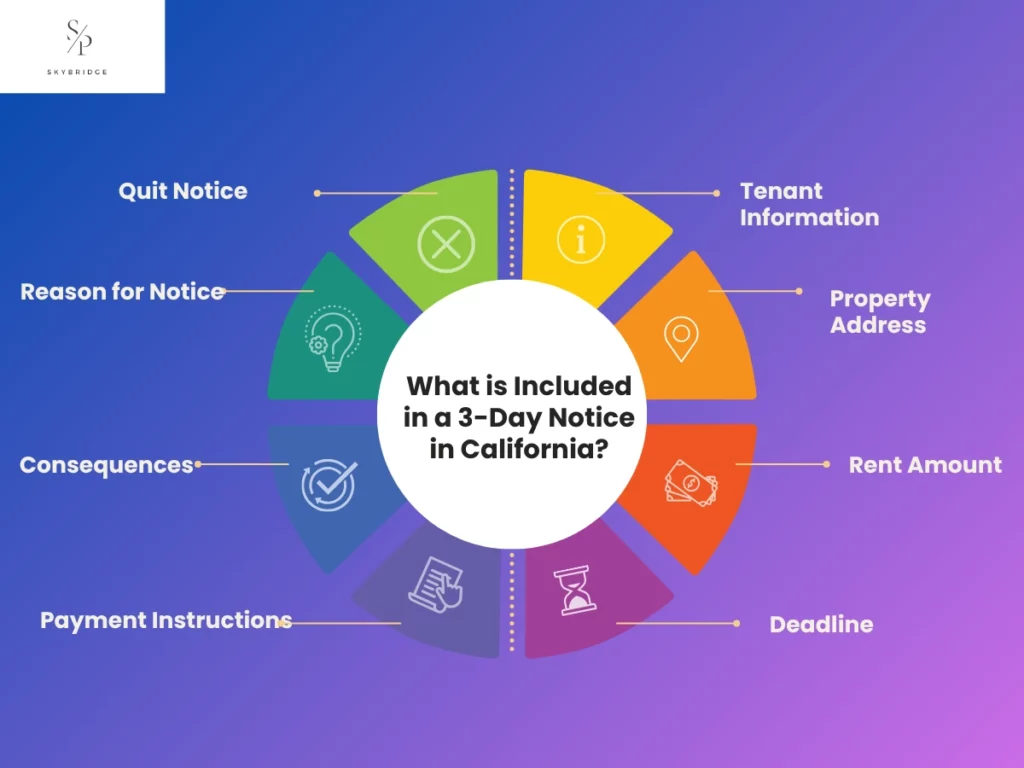
A 3-Day Notice in California must contain several key pieces of information to be legally valid. It should clearly state the tenant’s name, the rental property address, the rent amount owed (if applicable), the payment instructions, and the deadline for compliance. Failure to include any of these critical elements may invalidate the notice and delay the eviction process. The notice must be precise and adhere to California legal requirements to ensure its enforceability.
Tenant Information
The Tenant Information section must include the tenant’s full name, which must match the rental agreement. Any discrepancies or omissions in the tenant’s information could result in the eviction notice being deemed invalid.
Property Address
The Property Address section must provide the full and correct address of the rental property. Errors in the address can make the notice legally ineffective and complicate the eviction process.
Rent Amount
The Rent Amount section must state the exact amount the tenant owes, including overdue rent. If the lease specifies late fees, those can be included, but only if they are clearly defined in the rental agreement.
Deadline
The Deadline section must specify that the tenant has 3 full calendar days to comply with the notice. If served personally, weekends and holidays do not count as part of the 3-day period, which ensures the tenant is given a reasonable time frame to respond.
Payment Instructions
The Payment Instructions section must detail how and where the tenant should pay the rent. It should include acceptable payment methods, such as check or money order, and specify if payments can be made in person or by mail.
Consequences
The Consequences section must clearly state that failure to comply with the 3-day notice will result in legal eviction proceedings. It ensures the tenant understands the severity of non-compliance and the legal actions that may follow.
Reason for Notice
The Reason for Notice section must specify the reason for the notice, such as non-payment of rent or a breach of lease terms. It should also outline the corrective actions required, if applicable, to resolve the issue.
Quit Notice
A Quit Notice is issued when the tenant must vacate the property within the 3-day period. This is typically used when the tenant has failed to comply with the terms of the notice, and the landlord seeks to end the tenancy.
5 Common Mistakes That Can Void a 3-Day Eviction Notice
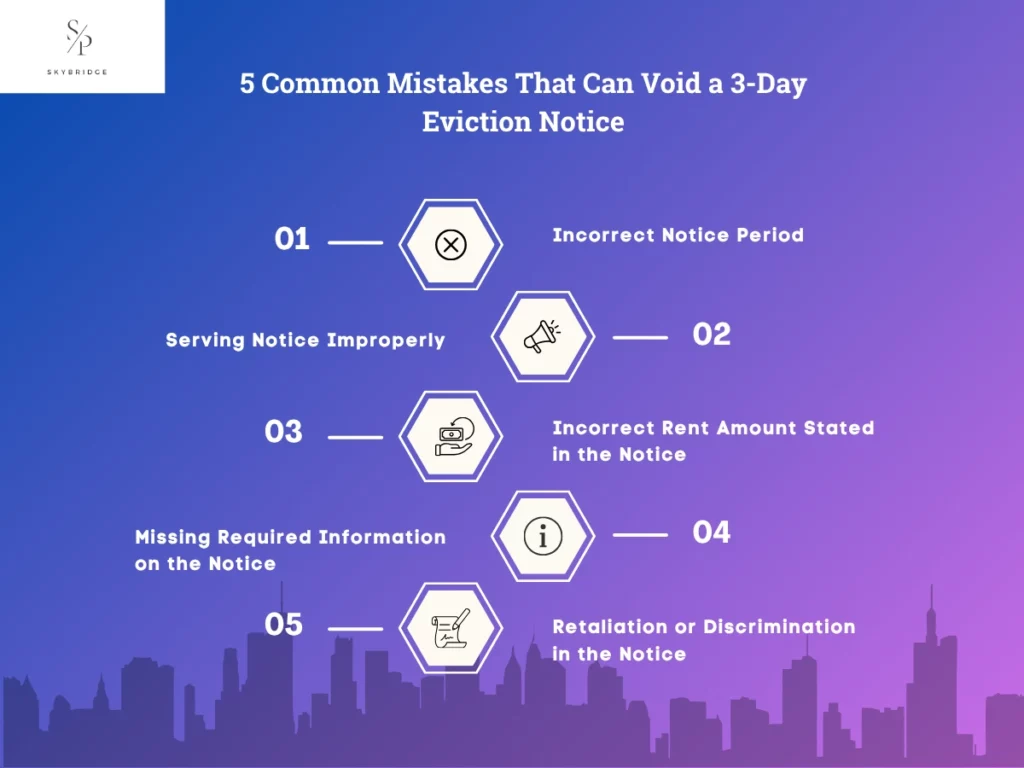
A 3-Day Eviction Notice in California can be invalidated by certain mistakes made during its preparation or service. Common errors include incorrect notice periods, improper service, incorrect rent amounts, missing required information, and issuing notices as retaliation or discrimination. These mistakes can delay the eviction process and may result in the case being dismissed by the court. Below are the most common mistakes and how to avoid them.
Incorrect Notice Period
An incorrect notice period can lead to the eviction notice being invalid. In California, the 3-Day Notice must provide three full calendar days for the tenant to comply, excluding weekends and holidays if the notice is served personally. For instance, if the notice is served on a Monday, the tenant has until Wednesday to respond. Incorrectly calculating this period could result in the court dismissing the eviction case. To avoid this, landlords should ensure that the notice specifies the correct compliance deadline and follow California’s rules on calculating notice periods.
Serving Notice Improperly
Improper service of a 3-Day Notice can invalidate the eviction process. California law requires that notices be served through specific methods: personal delivery, substituted service, or posting the notice at the property and mailing a copy. Failing to follow these procedures can lead to the notice being deemed invalid. To avoid this mistake, landlords should use a professional process server to ensure proper service and obtain proof of delivery, which is crucial for the eviction case.
Incorrect Rent Amount Stated in the Notice
The rent amount listed in a 3-Day Notice to Pay or Quit must be accurate and align with the lease agreement. If the notice states an incorrect rent amount, or if late fees or other charges are included without clear justification in the lease, the notice can be invalidated. To prevent this mistake, landlords should double-check the rent owed and separate unpaid rent from any additional charges. The amount stated in the notice must reflect the exact sum due.
Missing Required Information on the Notice
A 3-Day Notice must include certain essential details to be valid. This includes the tenant’s full name, the rental property address, the amount of rent owed, and the deadline for compliance. Omitting any of these critical pieces of information can lead to the notice being invalidated. Landlords should carefully review the notice to ensure that all required information is included before serving it to the tenant.
Retaliation or Discrimination in the Notice
Issuing a 3-Day Eviction Notice as retaliation or discrimination under the Fair Housing Act can invalidate the notice and result in legal consequences. California law prohibits evictions based on retaliation (such as after a tenant files a complaint) or discrimination against tenants in protected classes. A notice issued for these reasons is illegal and can lead to the eviction being dismissed. Landlords should always ensure that their reasons for eviction are legitimate and well-documented, avoiding any actions that could be interpreted as retaliatory or discriminatory.
What Happens After a 3-Day Notice to Pay or Quit in California?
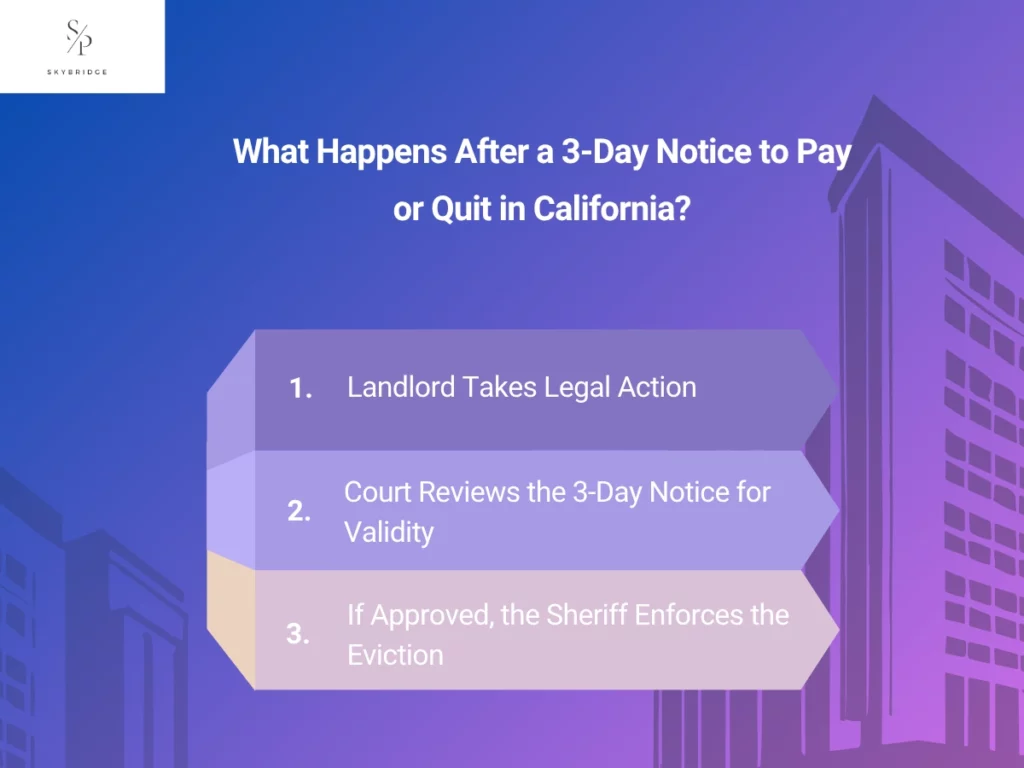
After a 3-Day Notice to Pay or Quit is served, if the tenant does not comply by either paying the overdue rent or vacating the property, the landlord may initiate legal action. This typically involves filing an unlawful detainer lawsuit (eviction lawsuit) in court. The court will then review the case, and if everything is in order, the eviction process will proceed accordingly. If the tenant complies within the 3-day period, the legal action is halted. However, failure to comply forces the landlord to take the necessary steps to move forward with the eviction process.
Step 1: Landlord Takes Legal Action
If the tenant does not comply with the 3-Day Notice, the landlord must file an unlawful detainer lawsuit in the local Superior Court. This lawsuit formally initiates the eviction process. The landlord is required to provide proof that the 3-Day Notice was properly served to the tenant and pay the applicable court filing fees. These fees vary by county. Filing the lawsuit is the first step in seeking a court’s assistance for eviction, with the landlord seeking the court’s intervention to regain possession of the rental property.
Action
The landlord files a lawsuit known as an unlawful detainer lawsuit, seeking legal eviction of the tenant.
Required Documentation
The landlord must provide proof of proper service of the 3-Day Notice, the lease agreement, and any additional documentation that supports the case.
Filing Fees
When filing an unlawful detainer lawsuit, the landlord must pay court filing fees. These fees vary depending on the county where the case is filed.
Court Summons
After the lawsuit is filed, the court will issue a court summons. The summons requires the tenant to respond within 5 days if personally served or 15 days if served by mail. This gives the tenant an opportunity to contest the eviction.
Step 2: Court Reviews the 3-Day Notice for Validity
In Step 2, the court reviews the 3-Day Notice for compliance with legal requirements. The court checks for common issues such as incorrect rent amounts, improper service, or missing required information. If any issue is found, the case may be dismissed. If the notice is valid, the court proceeds with the eviction process.
Action
The judge will review the 3-Day Notice to ensure it meets all legal requirements and accurately reflects the tenant’s violation.
Common Issues That May Invalidate the Notice
Common issues that may invalidate a 3-Day Notice include incorrect rent amounts, improper service (e.g., lack of proof of delivery), or if the notice was issued as retaliation or discrimination.
Outcome
If the 3-Day Notice is found to be invalid, the court may dismiss the case. The landlord would need to start the eviction process again with a valid notice.
Step 3: If Approved, the Sheriff Enforces the Eviction
If the court rules in favor of the landlord, a writ of possession is issued, allowing the sheriff to enforce the eviction. The sheriff’s role is to physically remove the tenant if they do not vacate within the specified period.
Action
The sheriff posts a 3-day notice to vacate on the property, giving the tenant a final opportunity to leave before enforcement.
Sheriff’s Role
If the tenant fails to vacate the property, the sheriff removes the tenant and changes the locks, ensuring the landlord regains access to the property.
Final Step – Physical Eviction
If the tenant refuses to leave, the sheriff will carry out a physical eviction, removing the tenant from the premises and allowing the landlord full access to the property.
What Happens If the Tenant Pays or Fixes the Issue?
If the tenant pays the overdue rent or fixes the issue, such as removing an unauthorized pet, the eviction process is immediately halted. The landlord may choose to stop the legal proceedings, and the tenant can continue their tenancy. Payment or resolution of the lease violation prevents further legal action and the eviction from proceeding.
What to Do If You Get a 3-Day Notice to Pay or Quit in California
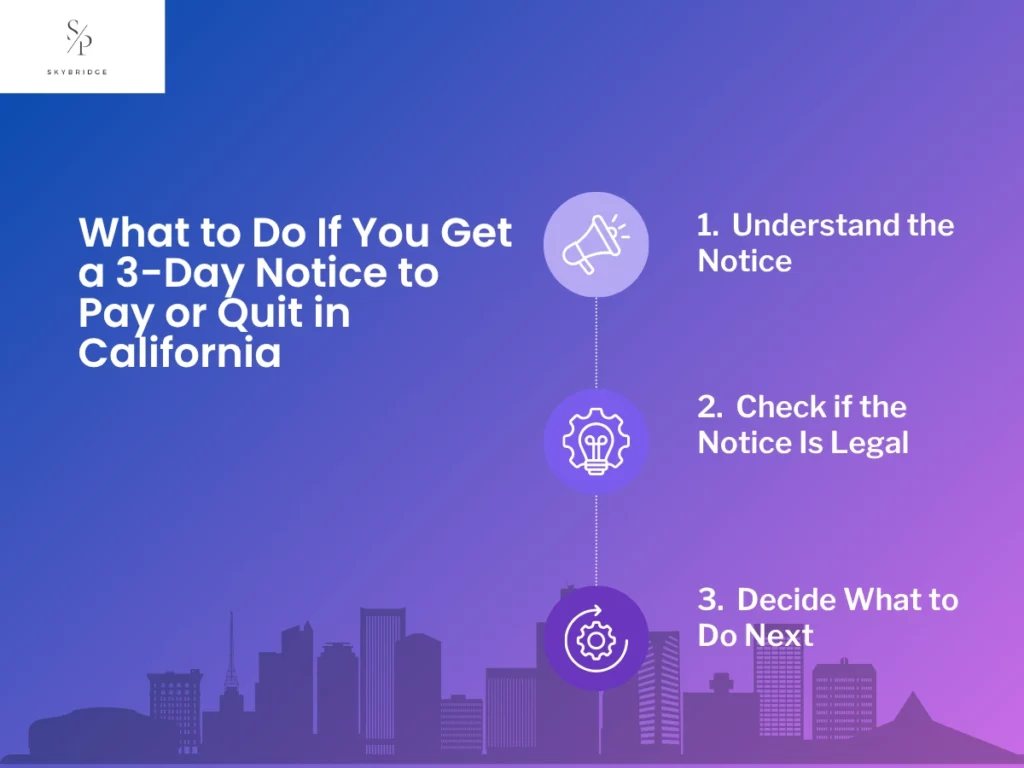
Receiving a 3-Day Notice to Pay or Quit in California can be stressful, but it’s important to understand what the notice means and what actions you should take next. Here’s a step-by-step guide to help you navigate the process.
1. Understand the Notice
When you receive a 3-Day Notice to Pay or Quit, it’s important to understand its meaning and your next steps. There are two main types: Pay or Fix (where you must pay overdue rent or fix a violation, like removing unauthorized pets) and Move Out (where you are asked to vacate the property). Check the deadline mentioned in the notice, if it’s a Pay or Fix notice, you have 3 days, excluding weekends and holidays. For Move Out notices, count every day, but if the last day falls on a weekend or holiday, the deadline extends to the next business day.
2. Check if the Notice Is Legal
Ensure the 3-Day Notice is legally valid. It must be delivered properly, either in person, by mail, or posted on the property with proof. Additionally, it should contain all required information, including your name, the rent amount (if applicable), and the compliance deadline. If the notice is not served correctly or lacks necessary details, the eviction may not be enforceable, and you may need legal assistance to confirm its validity.
3. Decide What to Do Next
Once you understand the notice, decide how to respond. If you agree with the notice, take action by paying the rent, fixing the issue, or moving out by the deadline to avoid eviction. If you partly agree or disagree, try discussing the matter with your landlord or use mediation services. If you ignore the notice or fail to act, the landlord can proceed with an eviction case, potentially leading to physical removal and a permanent eviction record.
How to Respond to a 3-Day Notice to Quit in California
Receiving a 3-Day Notice to Quit in California can be overwhelming, but tenants have several options to protect their rights and possibly prevent eviction. These options include paying the rent owed, fixing lease violations, negotiating with the landlord, challenging the notice if it’s invalid, and seeking legal help.
Pay the Full Rent
If the 3-Day Notice to Quit is issued due to unpaid rent, paying the full amount within the 3-day period, including any late fees specified in the lease, can cancel the eviction. It is essential to make the payment using the agreed-upon method (such as cashier’s check or money order) and within the designated timeframe. Partial payments will not stop the eviction process, so it is crucial to pay the full rent to resolve the issue and avoid further legal action.
Resolve Lease Violations
If the 3-Day Notice to Quit cites a curable lease violation, such as unauthorized pets or noise complaints, tenants must correct the issue within the 3-day period. It’s important to document the fix (e.g., removing the pet) and notify the landlord in writing that the issue has been addressed. This shows the landlord that the tenant has complied with the terms of the lease and can stop the eviction process.
Negotiate with Your Landlord
Tenants can try to negotiate with their landlord to avoid eviction. Proposing a payment plan, asking for an extension, or amending the lease terms might be viable solutions. If, for example, rent is overdue due to financial hardship, tenants can discuss a payment arrangement to catch up on overdue rent or request more time to make a partial payment. Open communication can sometimes help avoid the eviction process and keep the tenancy intact.
Challenge the Notice If It’s Invalid
If the 3-Day Notice to Quit is invalid, tenants have the right to challenge it. Common grounds for invalidating the notice include errors like incorrect dates, wrong property address, illegal fees included in a Pay Rent or Quit Notice, or improper service (such as leaving the notice under the door without mailing a copy). Tenants can raise these issues in court and, if successful, prevent the eviction from proceeding.
Seek Legal Help
If you are unsure of your rights or how to respond to a 3-Day Notice to Quit, seeking legal assistance is crucial. A lawyer or housing advocate can provide guidance, ensure that your rights are protected, and help navigate the process. Legal professionals can also help challenge invalid notices, negotiate with the landlord, or assist with filing defenses in court, which can be critical in preventing eviction or resolving the dispute.
How Property Management Services Can Help
Property management services help landlords navigate the eviction process by ensuring eviction notices are drafted correctly, legally compliant, and served properly. They also manage tenant relations, addressing issues promptly to reduce conflicts and prevent the need for eviction. From preparing the necessary documentation to overseeing the entire eviction process, these services help landlords save time and avoid costly mistakes.Skybridge Property Group, a trusted property management agency in Los Angeles, Diamond Bar, Pomona, Rowland Heights, and La Puente, specializes in Eviction Support. Our certified team expertly manages eviction notices, tenant communication, and the entire legal process, ensuring full compliance with local laws. We protect landlords’ interests and streamline the eviction process for maximum efficiency and minimal stress.

